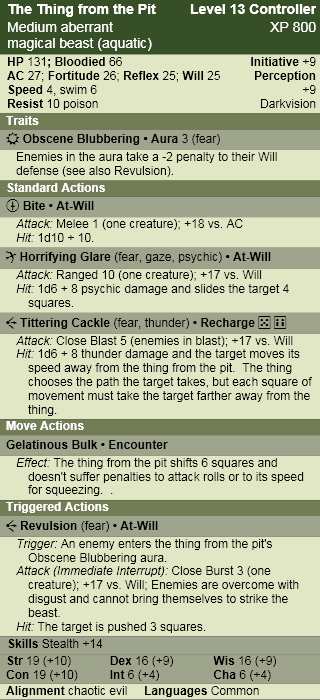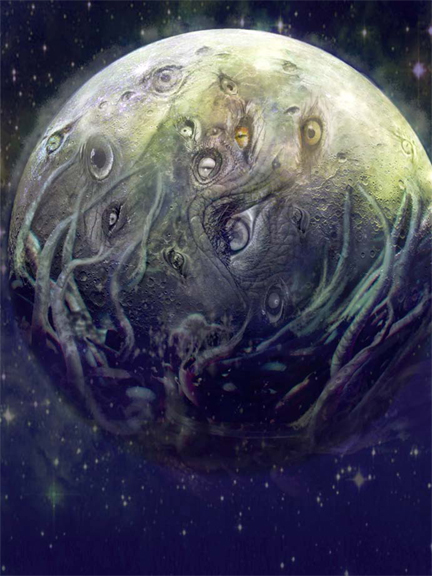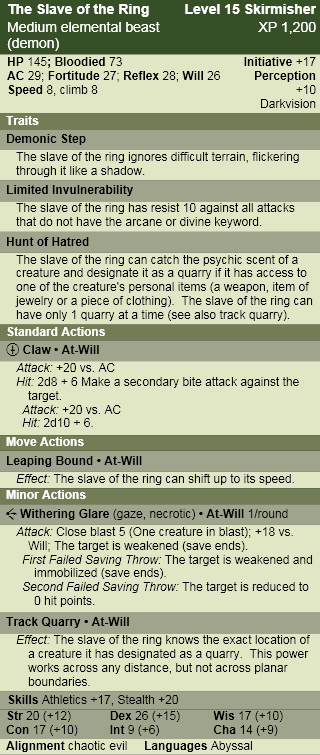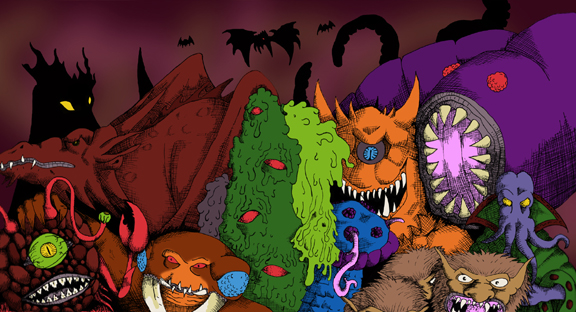Posts Tagged ‘D&D’
The Scarlet Citadel – Part One
December 22, 2010The Scarlet Citadel might not be the best Conan story ever written, but I think that page for page, it has more monsters than any other (and they’re some of the coolest as well). That made it pretty hard to narrow it down to a single creature to showcase… so I chose two instead (it’s the holidays). Like the title says, this is part one – I’ll post another fiend later in the week.
Spoiler Alert! All of these Hyborian age posts are going to be filled with spoilers. From the summary, to the monster stats they are going to ruin any surprises as to what the monster is, when they pop up in the story and how and why they are killed. You’ve been warned.
Summary
The second published Conan story takes place after the Phoenix on the Sword. Now that Conan has dealt with his internal enemies, he must now face the external threats to his kingdom. The tale begins with Conan on the field of battle, betrayed by Aquilonia’s neighbor, Ophir, to the King of Koth. Outnumbered his knights are quickly cut down and Conan is captured by the power behind the throne of Koth, the dark wizard Tsotha-lanti. The Kothians spirit Conan back to their capital and imprison him in the dungeons of Tsotha’s infamous scarlet citadel. Here Conan is given an ultimatum: continue to rule Aquilonia as a satrap of Koth or face death at the hands of the horrors below Tsotha’s citadel. As we knew he would, Conan rejects the offer (to put it mildly).
In the dungeons Conan encounters a huge albino serpent, a flopping tentacled thing whose sobs sound too human, an invisible floating creature (that mouths noiseless obscenities at him), and a vampiric plant that feeds on thoughts and memories. From the clutches of the devil plant Conan frees another sorcerer, Pelias, Tsotha-lanti’s chief rival (who might be just as bad as Conan’s captor).
With Pelias’ aid Conan flies back to Aquilonia astride a great bat winged monstrosity just in time to retake his capital and rally the troops. At the head of his army Conan rides southward to meet the armies of Ophir and Koth head on. In the ensuing slaughter the kings of both enemy nations are cut down and Pelias exacts grisly vengeance on Tsotha-lanti.
“Its unstable outlines somewhat suggested an octopus, but its malformed tentacles were too short for its size, and its substance was a quaking jelly-like stuff which made him physically sick to look at. From among this loathsome gelid mass reared up a frog-like head, and he was frozen with nauseated horror to realize that the sound of weeping was coming from those obscene blubbery lips. ” – Robert E. Howard, the Scarlet Citadel
Lore
Dungeoneering DC 20: The thing from the pit is the result of the wizard Tsotha-lanti’s twisted experiments with the Far Realm. Its form is so loathsome that few can overcome their disgust long enough to get within striking distance, and its cackling laugh can unnerve even the most stalwart of warriors.
The Thing from the Pit in Combat
The thing from the pit revels in the fear and disgust it inspires; taking great delight in driving its enemies into deadly traps and other hazards.
Encounters
There are few creatures that can stomach the company of the thing from the pit save mindless oozes and other, equally deformed, aberrations. The latter find the thing from the pit’s ability to shepherd prey across the battlefield invaluable.
Notes
This creature doesn’t play that large a role in the story but it really grabbed my attention. Its appearance was so bizarre it was hard to ignore, and more importantly, it freaked Conan out so much that he flees rather than try to fight it. It made Conan run away. This is the same guy who earlier in the story was able to hold perfectly still while a giant snake reared over him dripping acidic burning venom onto his legs. I wanted the thing from the pit’s powers to reflect that. The creature isn’t much of a threat on its own, but you combine it with other creatures, hazards and traps and I think it becomes quite deadly (in the story it almost gets Conan to fall down a well in his flight from it).
Even though this story takes place after the phoenix on the sword, I decided to make it a lower level than the slave of the ring – Tsotha-lanti’s creation just doesn’t end up hurting Conan like Thoth-Amon’s summoned demon did.
In terms of the picture I found it quite a challenge to draw, and going by Howard’s description it went through a few iterations. In the end I opted for a less true octopoid body and instead drew inspiration from Jim Holloway’s illustration of the yochlol from the 1e Monster Manual II.
Random Encounters: Paean for the Outer Dark
December 18, 2010I was up late staring out the window, thinking about star pact Warlocks (I love the implied setting of these characters), the dark void between the worlds, and Deities and Demigods (with tentacles) when a certain song by Rush came on…
Which led me to uncover this lost scrap of arcane knowledge, acid etched into paper thin sheets of adamantine:
Excerpt from Paean for the Outer Dark
Invisible to telescopic eye
Dark Hadar
The star that would not dieAll who dare
To seek her source
Are swallowed by
A deadly forceThrough the void
To be destroyed
Or is there something more?Atomized — at the core
Or through the astral door —
To soar…I set a coarse just east of Caiphon
And northwest of Acamar
Flew into the light of Delban
Sailed beyond the cold white starsOn my ship the ‘Sea of Fate’
Wheeling through the great beyond
Headed for the heart of Ihbar
With the black blade that it once spawnedBlackrazor, her siren song
My ship cannot resist her long
Nearer to my deadly goal
Until the black hole —
Gains control…
-translated from the original Deep Speech by the mad poet L’iel Prane
The Phoenix on the Sword
December 14, 2010For Monsters of the Hyborian Age, I’m going to be covering the stories in the Complete Chronicles of Conan in publication order (coincidentally the order that they appear in the book) rather than the chronological order of Conan’s life. There are a few reasons for this. The first is that the chronological order is highly contested; with at least 3 different versions (I’m partial to Dale Ripkke’s). The second reason is that publication order is probably the order that they were intended to be read (imagine watching all 6 Star Wars films in chronological order – all of the anticipation and mystery of the original trilogy would make no sense). Finally, like the ‘Bond rule’ (the first actor you see playing Bond is the one whom you feel portrays him best), this is the order that I read them in so it subjectively just feels right to me.
Spoiler Alert! All of these Hyborian age posts are going to be filled with spoilers. From the summary, to the monster stats they are going to ruin any surprises as to what the monster is, when they pop up in the story and how and why they are killed. You’ve been warned.
Summary
The first Conan story, oddly enough, begins with the barbarian towards the end of his career. He is middle-aged and has become king by his own hand over the most powerful nation in the world, Aquilonia. But it is not an easy rule. A group of four influential conspirators works behind the scenes to end the new king’s rule and replace him with one of their own. While Conan was first hailed as a savior for killing the tyrant Numenides, the public (encouraged by the ‘rebel four’) chafes at being ruled by a foreigner. To this end the rebel four uses Ascalante, a deposed nobleman and his slave Thoth-Amon, once a powerful Stygian wizard, but bereft of magic since the loss of his powerful ring.
The rebel four plans on assassinating Conan with their own hands while he is defenseless. As the tangled conspiracy unfolds we learn that Ascalante plots against the rebel four even while he helps them, hoping to betray them at the last moment. Likewise his slave, Thoth-Amon plots against his master for the humiliation he has suffered at Ascalante’s hands.
While the rebel four and Ascalante put their plan into motion, fate deals two wild cards. First Thoth-Amon finds his magic ring and uses it to summon a powerful demon to track down and destroy Ascalante. Second, Conan is visited in a dream by the ghost of the sage Epemitreus who warns him of the im pending assassination and imprints his sword with the mystical symbol of the phoenix.
pending assassination and imprints his sword with the mystical symbol of the phoenix.
All threads come together in the king’s bedchamber as Ascalante and the rebel four find Conan awake and ready for them. Before battle can be joined Thoth-Amon’s demon enters the fray, destroying the would-be assassins and attacking Conan. Using his now magical sword, the king is able to slay the unstoppable beast and send it back to the abyss.
The Slave of the Ring
“Its outline was not unlike that of a gigantic baboon, but no such baboon ever walked the earth, not even in Stygia… The hideousness of its face transcended mere bestiality. It might have been the face of an ancient, evil mummy, quickened with demoniac life. In those abhorrent features the outlaw’s dilated eyes seemed to see, resemblance to the slave Thoth-Amon. Then Ascalante’s cynical and all-sufficient philosophy deserted him, and with a ghastly cry he gave up the ghost before those slavering fangs touched him.”
-Robert E. Howard, the Phoenix on the Sword
Arcana DC 20: The slave of the ring is a shadowy demon bound to a mystical talisman dedicated to the Stygian god, Set. Brought forth from the ring by means of a foul ritual, the demon serves its master as a peerless tracker and assassin.
Arcana DC 25: Woe to anyone who meets the slave of the ring’s terrible gaze, for its swirling yellow orbs have the power to shrivel a mortal’s soul in their baleful radiance.
The Slave of the Ring in Combat
Once the slave of the ring has its target’s psychic scent it is nearly impossible to evade. The demon stalks its prey, waiting until its target is distracted (typically in combat) to strike. It takes full advantage of its advanced mobility, skirting around defenses and rending softer opponents with their deadly talons.
Encounters
The slave of the ring is conjured into the world at the behest of its master, usually a powerful Wizard, Warlock, or Cleric (Yaun-Ti spellcasters favor the summoning of the slave of the ring to dispatch political opponents). Such a master might send other servants to accompany the demon (usually skirmishers or lurkers) or attend personally to ensure it fulfills its task.
Notes
When Conan fights the slave of the ring, he feels more like an upper Paragon tier character rather than an epic one (becoming king by your own hand feels more ‘paragon path’ than ‘epic destiny’), so I chose to make the creature a level 15 challenge. The demon’s limited invulnerability trait is meant to emulate its resistance to normal weapons and its vulnerability to Conan’s enchanted blade. I wanted to play around with power sources, since I haven’t really seen anything that makes use of those keywords. If there are a lot of PC’s in the party with these power sources you should probably increase the resistance to 15. If there are few PC’s you might want to place a magic weapon in the adventure with a trait that makes all attacks with it have the arcane or divine keyword (inscribed with a phoenix of course).
Monsters of the Hyborian Age
December 12, 2010 The first ongoing project I want to work on is translating the monsters of the classic Conan stories to D&D 4th edition. It may be well trod territory (in previous editions at least – look at Arny on that 1e module cover!), but beyond the cool subject matter, I’d like to see if I can push the 4e mechanics by using elements in new ways, not just re-skinning goblins and orcs (over ambitious I’m sure).
The first ongoing project I want to work on is translating the monsters of the classic Conan stories to D&D 4th edition. It may be well trod territory (in previous editions at least – look at Arny on that 1e module cover!), but beyond the cool subject matter, I’d like to see if I can push the 4e mechanics by using elements in new ways, not just re-skinning goblins and orcs (over ambitious I’m sure).
In the famous ‘appendix N’ of the 1st edition Dungeon Masters Guide, Gary Gygax cites a list of books for inspirational reading that were literary influences on the game. Among these he lists Robert E. Howard’s Conan stories, and after the list reiterates that Howard (along with L Sprague de Camp, Fletcher Pratt, Fritz Leiber, Jack Vance, A.A. Merritt, and H.P. Lovecraft) had a particularly immediate influence on the game (Gygax also later claimed that Tolkien had little influence on the game, which is interesting but that’s a whole other can of worms). Now I’d seen the Conan movie (and still love it despite all the haters), and I’ve got a fair collection of Marvel’s Conan comic books, but I’m ashamed to admit I’ve never read any of the original Conan books. So in the spirit of getting in touch with my favorite hobby’s roots I picked up a copy of The Complete Chronicles of Conan, Centenary Edition and set about to educate myself.
First, the stories are great and the influence on D&D is clear on every page. I was surprised by Howard’s female characters, who seem more nuanced and powerful than most adventure fiction (yeah they’re sex objects as well but I had a lot less cringes reading this than re-watching Indiana Jones and the Temple of Doom – and this was written in the 30’s). I was disappointed by Howard’s portrayals of race, which made me feel uncomfortable and complicit (in a way, since I was reading the words), and sometimes threatened to break my immersion into the story. I don’t think this condemns the work outright any more than it would Huckleberry Finn or The Merchant of Venice, but it’s there. At least there were times when you coul d see that Howard was struggling with his views, testing out the boundaries of his own beliefs, something I never got the impression of when reading H.P. Lovecraft.
d see that Howard was struggling with his views, testing out the boundaries of his own beliefs, something I never got the impression of when reading H.P. Lovecraft.
The greatest part of the stories though, was the monsters! Now when it comes to the subject of bringing Conan to D&D, the prevailing wisdom has been that the Hyborian age was monster light. I have to say after reading the stories, if Conan’s exploits are any indication of the kinds of adventures that can be had, there was at least one (but usually more) monstrous opponent in each tale. Sure there were very few monster races, most of the creatures were unique, but you couldn’t flip over a rock without uncovering some alien god or bloodsucking demon. Besides, the idea is to create D&D monsters using the stories as source material, not create a Hyborian age 4e game.
I’m hoping to do a Hyborian monster every week or two, complete with illustration (because web content without a picture is one of my pet peeves). I might be biting off more than I can chew, but that’s what being a steel thewed barbarian is all about (that and passing out into a giant bowl of oatmeal).
These Are A Few Of My Favorite Things
December 9, 2010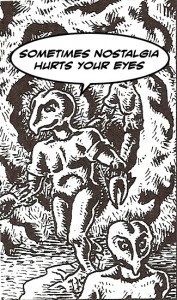 The blog’s background image is an homage not just to my favorite D&D monsters, but also to my favorite old school artists. The images of early D&D products really captured my imagination as a child, so part of my love for them is pure nostalgia. When I picture a purple worm, in my head it has eyes (the memory is also wrapped up in playing the Dungeon! boardgame while listening to Prince’s Purple Rain as well, but that’s another story), even though the new-style, more alien looking purple worm looks a lot cooler. Now I’m not slagging the art used in rpgs now, without question it is of a much higher technical standard (and some old school art is abysmal, take a look at the crabman from the original Fiend Folio). Wayne Reynolds, for example, is an incredible artist (I especially dig his ‘wall of action’ stuff, like the 3.5 DM screen Paizo put out), but there’s no way in hell I can emulate the style of Wayne Reynolds, I’m just not that good (in fact I’m not really an artist at all). But that’s also part of the attraction of old school art. Looking at an early Erol Otus or Bill Willingham picture I get the impression that with enough practice and a little luck I could draw like them. In a hobby that emphasizes do-it-yourself and fan-created material this kind of realistic goalpost gives the pieces special meaning. Even though I’ve never met them, it created a special kind of bond between me and the D&D artists of my childhood. In the end it’s probably just a fancy way of justifying my nostalgic over attachment to these images and my poor art skills, but hey isn’t that what blogging’s all about?
The blog’s background image is an homage not just to my favorite D&D monsters, but also to my favorite old school artists. The images of early D&D products really captured my imagination as a child, so part of my love for them is pure nostalgia. When I picture a purple worm, in my head it has eyes (the memory is also wrapped up in playing the Dungeon! boardgame while listening to Prince’s Purple Rain as well, but that’s another story), even though the new-style, more alien looking purple worm looks a lot cooler. Now I’m not slagging the art used in rpgs now, without question it is of a much higher technical standard (and some old school art is abysmal, take a look at the crabman from the original Fiend Folio). Wayne Reynolds, for example, is an incredible artist (I especially dig his ‘wall of action’ stuff, like the 3.5 DM screen Paizo put out), but there’s no way in hell I can emulate the style of Wayne Reynolds, I’m just not that good (in fact I’m not really an artist at all). But that’s also part of the attraction of old school art. Looking at an early Erol Otus or Bill Willingham picture I get the impression that with enough practice and a little luck I could draw like them. In a hobby that emphasizes do-it-yourself and fan-created material this kind of realistic goalpost gives the pieces special meaning. Even though I’ve never met them, it created a special kind of bond between me and the D&D artists of my childhood. In the end it’s probably just a fancy way of justifying my nostalgic over attachment to these images and my poor art skills, but hey isn’t that what blogging’s all about?
My favorite things from left to right:
Eye of the Deep: Beholders are one of D&D’s most iconic monsters, and I’ve always felt that its undersea cousin needed a bit more love. Before I knew any better I thought the eye of the deep was more powerful than the beholder – it had pincers and eye rays! (Inspired by Jean Wells’ illo. from the Monster Manual).
Red Dragon: They’re in the game’s name, you can’t do a picture featuring D&D monsters and not include them… plus, I really like dragons. (Inspired by any Jeff Easley dragon – including Jeff Easley in here kind of busts my whole ‘I could draw like them’ idea. There’s no way I could really emulate his style but I absolutely adore his paintings so I at least tried to capture the form of his dragons).
Water Dragon (silhouette): I’m actually not sure what kind of dragon this was. It could just as easily been a green dragon, but it’s hard to tell. (Inspired by Erol Otus’ cover for the Basic Dungeons and Dragons rulebook).
Umber Hulk: Once upon a time umber hulks were hulking. And for the record the color scheme is not inspired by (awesome) Olympic mascot Quatchi, I was going more for the rubber umber hulk made by LJN Toys in the 80’s. (Inspired by Jeff Dee’s illo. from the module The Ghost Tower of Inverness).
Jubilex: The dungeons of D&D are teeming with a cornucopia of oozes and slimes. If I’m going to draw a picture of one why not go for the granddaddy of them all. (Inspired by David A. Trampier’s illo. from the Monster Manual).
Stirge (silhouette): As a kid I spent a lot of summers in mosquito infested northern Ontario, so these bloodsuckers hold a certain resonance with me. (Inspired by David Sutherland III’s illo. from the Monster Manual).
Violet Fungi: With so many fungal based monsters in the game, I blame D&D for giving me the paranoid belief that eating mushrooms will infect me with their spores. (Inspired by Erol Otus’ illo. from the module Expedition to the Barrier Peaks).
Astral Dreadnought: This behemoth (not really to scale), never got a set of official stats until 2nd Edition even though it graced the cover of the Manual of the Planes. (Inspired by another great Jeff Easley painting).
Bugbears: While I was DMing The Temple of Elemental Evil in high school, the rules for reinforcing the forces of evil combined with the long healing times of the PC’s to create a population explosion of these critters. Ever since bugbears and I have had a bad reputation. (Inspired by Erol Otus’ illo. from Hackmaster).
Purple Worm: Better than a Shai-Hulud. (Inspired by David Sutherland III’s illo. from the Monster Manual).
Mind Flayer: Saved the best for last. Brain eating, mind controlling, tentacle creatures from the bowels of the earth. What’s not to love? (Inspired by the Bill Willingham illo. from the module Descent into the Depths of the Earth).
Another Visitor. Stay Awhile. Stay Forever!
December 7, 2010Monsters are my obsession. If I looked for one thread that tied together all of my disparate interests: comics, movies, art, writing, religion… it would be my fascination with monsters. That’s what this blog is about, following that thread (and indulging my obsession) into the heart of monsterdom.
But my love of monsters is inexorably entangled with my love of role-playing games. Pretending to be Gandalf or Robin Hood isn’t what first drew me to Dungeons & Dragons when I was a kid – it was seeing the hordes of slavering monsters creeping through the pages of my brother’s copy of The Keep on the Borderlands and the Monster Manual. So I can’t help but write from the perspective of a die-hard gamer.
Welcome to Ménage à Monster. Watch where you step.
